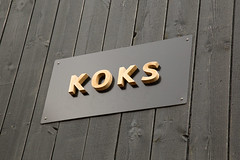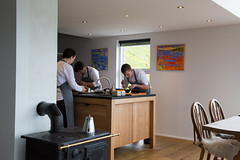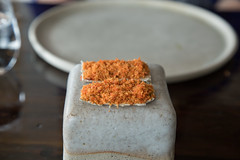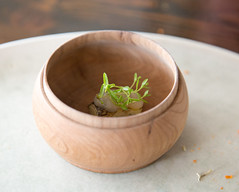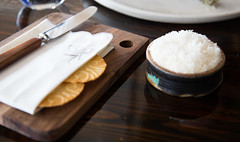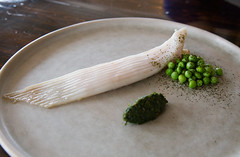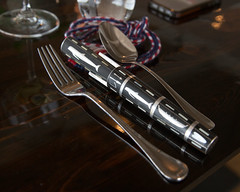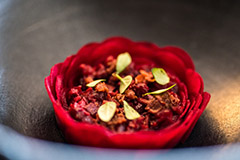(Update: As of early 2022, Koks has moved again, and will be serving from Ilimanaq Lodge, Greenland for 2022 and 2023 as they work out real estate issues in the Faroe Islands. In 2024, they announced a temporarily closure after the 2024 season as they leave Ilimanaq Lodge but have not found suitable Faroe Islands accommodations yet.)
“Faroese Cuisine” isn’t generally one of the well-known cuisines in Europe. But the Faroe Islands do have one restaurant that’s frequently mentioned as an actual culinary destination, with regular mentions in such publications as The New York Times, The Guardian, and even The Economist! That place is Koks. Located in a converted house overlooking the scenic village of Kirkjubøur, Koks is a fine dining restaurant that, like many others, prides themselves in local ingredients and traditions. It’s just that here, chef Poul Andrias Ziska is using the local ingredients and traditions of the Faroes, which are quite interesting indeed.
They’ve gotten a rather large number of awards, including multiple wins of the “Best Restaurant in Scandinavia”. So when our travels had a free evening on the island of Streymoy, I was able to secure a reservation and we headed off to the village (Note: the restaurant moved to Kirkjubøur in early 2016, so a lot of reviews mention its older location in the Hotel Foroyar in what’s now Gras).
Upon arrival, we found ourselves greeted pleasantly, and seated at a nice wooden table with a view that, quite frankly, was awesome in itself.
I’ll have to say, the view itself was awesome in itself. So we sat down and drank a nice aperitif as we pondered the menu (served up on an iPad, in an interesting blend of modernism and traditionalism) and watched the sous chefs meticulously plate the dishes before they came out to the tables (often with tweezers, for Eric Ripert-like precision). The food at Koks doesn’t come cheap (indeed, at over 2100 DKK ($300) per person including the wine pairing, this was one of the most expensive meals I’ve ever had), but it does come as an elaborate 7 course tasting menu with what turned out to be one of the best-curated wine pairings I’ve ever had.
Before we get into the proper reviews, it’s worth talking a bit about Faroese cuisine. The Faroese life has always been a bit of a hard one, with the small chain of islands having few resources other than “grass” and “ocean”, and the resulting traditional cuisine is probably best described as “extreme Nordic”, with a heavy reliance on sheep, fish, whales, and, when these items aren’t in season, preserved versions of same. Indeed, one of the main traditional Faroese dishes is skerpikjøt, which is basically air-cured leg of mutton: a leg is hung to dry in a hjallur, a open-slatted wooden shed, to dry in the wind upwards of 9 months, resulting in an intensely flavored, and interestingly textured product. Similar dishes involve preserved pilot whale meat, dried fish, and interesting spreads made from fermented lamb’s fat. So it’s not a cuisine for the faint of heart. But, on the other hand, it can have its rewards as well. In the words of a Faroese student we met on one of the ferries, “It’s great to come back home from Denmark. Here the food has flavor.” And, as we found, flavor it indeed has.
And, after enjoying a pleasant Charles Dufour Bulles de Comptoir #4 Champagne, our first light appetizer arrived: Greytur. The word means “porridge”, but in the case, the the porridge has been deep-fried in little cubes. Despite the very unusual presentation and somewhat unique texture (very earthy and chewy), this dish worked surprisingly well and was a great start.
Our next dish dove right into seafood, with Kufiskur (Mahogany clam). Served up over a plate of hot pebbles, this was served up dill oil sauce, little discs of kelp-flavored gelatin, and thin slices of radish. I’m not generally a fan of clams, but everything worked about this dish: the delicately cooked clam combined very nicely with the kelp gel and dill cream sauce, and I ended up chasing most of the tasty bits around the beautiful red shell. This is how I can enjoy some shellfish.
Then, our first divisive course: øða. Another traditional Faroese ingredient, this is “horse mussel”, and in this rendition, it has been dried and shaved into a parmesan-like powder, and served over a “cracker” of dried cod skin. Despite my generally dislike of such things, I actually enjoyed it a bit, the horse mussel having a bit of a nutty flavor, and the cod skin having a nice texture, although it was a bit fishier than I usually care for. Somewhat surprisingly, Carol rather disliked it.
Our next course was one of the big attractions: I finally got to try a variety of Skerpikjøt, the famous air-dried mutton of the Faroes. Here was it served up in a sashimi-like manner, as a wafer-thin slice over a bed of dried reindeer moss. This dish was interesting, to say the least. The skerpikjøt was basically one of the most intensely-flavored meat items I’ve ever had. You know how when you have a good Iberian ham the flavor is deeply concentrated and rich? This was similar, but the base flavor is instead an intensely gamey mutton. Really, really intense. Despite that, I mostly enjoyed it, although the bits around the edge had a bit of an odd funk to them. The reindeer moss underneath was a really odd flavor combination and a bizarre texture that I’d describe mostly as “mossy shredded wheat.” All that said, I rather enjoyed it, although it wasn’t the sort of thing I’d want a lot of: one thin slice was enough.
Next was an odd little dish: Purra. Described as “Fermented leek”, this was a slice of same, served up with greens. This was a truly intriguing dish, since the flavor was somewhat unique. You know how an onion smells when it has started to rot? Well, this tasted kinda like eating a rotting onion, but in a good way. I actually liked this dish, and wish there was more of it.
Next up was another Faroese traditional item: Garnatalg. One of those little dishes where the description defies simple translation, basically, this is a spread made from fermented lamb’s fat mixed with cheese and topped with dried fish flakes, served up with a set of crackers. I enjoyed this way more than I thought I would, although, like the skerpikjøt, it had a bit of an odd, rancid-like flavor. It would take me a while to get used to this dish.
Usually when I go to these sorts of high-end restaurants, there’s at least one course that has me going “That’s it?!”, usually since the dish is overly minimalist. In this case, it was two nasturtium leaves with a dollop of rhubarb compote. Not bad… but also not much really there. I literally could walk outside at home and come back inside with the makings for this in about 30 seconds. Enjoyable, but not really sure what this added to the overall course structure, aside from serving as a mild palate cleanser.
After the nasturtiums, we moved on into the actual main courses, and resumed the wine pairings. While sipping on a very pleasant 2014 Domaine Marquis d’Angerville Bourgogne Aligote, they served up another unusual dish: Langskel og urtir: razor clam, pea puree, and greens, under what was described as a “burnt leek cracker”. Which was exactly that. Very much to my surprise, this actually worked really, really well: the clams were delicious and tender, and the little bits of burnt leek actually worked a lot like caramelized onions. Alas, once you started picking at it, you couldn’t really photograph it any more.
The next dish was conceptually quite similar: Krabbi og leykur (Crab and onions). Steamed crab with puffed buckwheat and elderflower: again, a perfectly cooked bit of crab with an interesting sauce with some really nice onion notes. Texturewise, this was one of the more interesting and enjoyable dishes, and it was paired very nicely with a white burgundy (2014 Pierrette et Marc Guillemot-Michel).
Next up was the masterpiece of the meal: Hummari og Grann. They brought out a pair of covered bowls, each containing a langoustine, an actually burning and smoldering chunk of dried spruce, and several hot, wet rocks. The result was absolute perfection: the langoustine was just barely cooked, and got a good amount of smoking from the spruce, and the rocks retained the heat and moisture. I’ve never had a more delicious and perfect piece of langoustine, and indeed, this was (so far at least) the finest single food item I had in 2016. Paired with a nicely subtle Chardonnay (2014 Stephane Tissot Arbois Chardonnay les Bruyeres), and this course was absolutely stunning.
Next up was a more straightforward dish: Skøta og Ertur (skate with peas and lovage pesto). Skate is another one of those seafood items I usually don’t have, and often when I do, it’s rather cartilaginous. But here it was cooked to absolute perfection, scraping little bits of skate off and dabbing them in the suprisingly tannic pesto, this was another combination that basically just worked.
For some reason the next course was served up with a traditional Faroese whale knife (historical aside: Faroese whaling tradition is different: they use boats to drive the whales into shallow fjords and then kill them with ornate whaling knives). The dish itself was Kalvi og Brenninota, which is poached halibut served up on a bed of nettles. This dish worked quite well: the halibut was perfectly poached, and the slightly acidic nettles gave a nice herbal note to the dish. Only oddity was that the whale knife was completely overkill: the halibut was fork tender. This course was also notable for a nice pairing Sol a Sol 2009 from La Mancha. Labeled a “Vino Blanco”, this wine is actually one of the darker whites we had, orange in color, and had a wonderful deep, earthy flavor to it.
For the next course… Well, I’ll stop here and mention one of my biggest mistakes as a food photographer. I forgot to photograph one dish, and it was easily one of the most memorable dishes I’ve ever had: fulmar breast served up in a nest of beetroot and rose hips. Memorable in a bad way, mostly. I say this, because…. Fulmar (a seagull-like bird inhabiting many of the cliffs of the Faroes) is seriously one of the most disgusting bits of bird I’ve ever eaten. It was like bad grouse reeking of urine and rancid mackerel. Way worse than puffin. I will definitely be tasting that for a long time. But, in fairness, I can actually see why some people may like it (it does have some of the nicer qualities of both pheasant and anchovies). And, for that matter, Carol didn’t think it was that bad. Many thanks to my fellow bloggers at Life and All who dined a week earlier and did capture a photo of this most memorable dish. And, while I didn’t care for the dish itself, it was also paired with a nice Pinot from Schaltter Maltesergarten.
The fulmar was the last main dish before the dessert courses, and they did offer up a bowl of Sitronjarnut og Timian: lemon verbana tea with thyme oil in it. This was actually quite pleasant, and served its purpose quite well; it almost washed the rancid nasty taste of fulmar out of my mouth.
Closing out the meal was a pair of desserts. First was Sýra og Rómi: Sorrel and Cream. Tasting a bit like a bitter green tea ice cream, I actually enjoyed this, as well as the nice 201 Spätlese “Mandelgarten” Riesling.
Rounding out the desserts were some cookies (not shown), and this really weird dessert: Søl og Bláber, made with fermented blueberries, dulse (a seaweed they literally pick up from the beach), dried chocolate, and a few other things. Taste-wise, this was awesome. Texture-wise, it as a bit like a fruit rollup, but I had never before realized that “Blueberry” and “Seaweed” actually combine well. Rounded out with another pleasant wine, this time a 2014 Muscadelle from Robert & Bernard Plageoles in Bordeaux, and this was a great dessert.
Overall, I’m rather pleased with Koks. As I mentioned this was not a cheap meal (indeed, one of my most expensive non-Thomas Keller meals), but it was memorable for many reasons. The flavors were indeed different, and extremely bold. The courses were all interesting, and even when I didn’t care for them (Carol is probably still wondering when I’ll shut up about the fulmar), I could see what the were doing. And the langoustine was indeed one of the finest things I’ve ever eaten. It’s a real accomplishment to me that a restaurant could, simultaneously, offer up one of the best meals I’ve had in a long time, with one of the finest wine tastings I’ve ever had, while having that meal contain one of the most seriously nasty things I’ve been offered. The only reason I’d hesitate to come back is that I’d like to make sure it was in a different season (to get different seasonal dishes). And I may grovel for a substitution for the fulmar.
Oh, and another thanks to Life and All for stepping in for my missing fulmar picture. And worth reading their experience as well, since they opted for the fruit juice pairing instead, and got a slightly different set of dishes.

